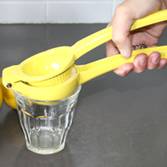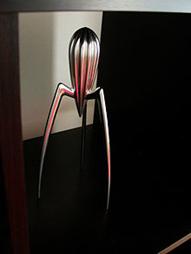Design Resource
Kitchen Products
The Sanctum Sanctorum of the Indian household
by
A lemon squeezer is a small kitchen aid or kitchen mate designed to extract juice from lemons or other citrus fruits such as oranges, grapefruit, or limes. The functioning of the lemon squeezer is simple - pressure is exerted on a lemon to force its juice and pulp from its rind.
It is also designed in a way that is easy to operate and to extract the juice. Lemon juice is very acidic, so the squeezer can only be made from any solid, acid-resistant material, such as plastic, glass, or metal, usually stainless steel.
History
The oldest known lemon squeezers were found in Kütahya, Turkey and date to the first quarter of the 18th century. These were individually made, and specially designed for making the then popular citrus drink sorbet. Lemons are not native to northern Turkey, though during the 17th and 18th centuries they were imported in bulk to Constantinople.
At the end of the 19th century a large number of different models of lemon squeezers were patented in the United States. The U.S. Patent and Trademark Office list over 200 patents for lemon squeezers, the majority of which were registered between 1880 and 1910 !
But over the number of years numerous lemon squeezers have been designed and manufactured and in the present day too, one has a multitude of varieties to choose from.
Varieties of Lemon Squeezer
The most commonly used lemon squeezers are the bowl shaped ones or the hand held ones. These are available in plastic glass or stainless steel. Some of these are available in round, oval, square, or hexagon shapes too.
In the bowl shaped ones there is a conical ridged centre connected to a perforated plate .This plate is seated on a collecting bowl.
By centring the halves of a lemon with their cut-side down over the ridged conical top, a user presses them and turns the lemon half back and forth to extract lemon juice. The purpose of the perforated plate is to separate the seeds, and let only the lemon juice filter down into the container.
Bowl shaped lemon squeezer in plastic
Each manufacturer produces quality, innovative designs with a fine finish. The technically designed operating mechanisms of these squeezers help in squeezing juice from lemons easily.
The hand held lemon squeezers have two handles, (one on top of the other) with two small cavities at one end of each handle. The cavity on the upper handle is smaller than the one in the lower handle. The two handles are hinged at the cavity end in such a way that the handle with smaller cavity is seated over the handle with the slightly larger cavity. The larger cavity has perforations in it which allow only the lemon juice to flow down and not the seeds.
A lemon half is placed inside the cavity of the lower handle and the upper handle is pressed down. When both the handles are pressed together the juice from the lemon half flows out.
All of them are specially designed to avoid squeezing bitter juice of the lemon seeds.
They are usually made out plastic, stainless steel and aluminium. The ones made of stainless steel are known for their sturdiness and durability. They have distinctive features such as being long lasting, rust proof and easy to clean.
Hand held lemon squeezer in stainless steel
Instructions to squeeze juice out of a lemon
Things Needed:
• Fresh lemons or limes (small)
• Hand lime squeezer
• Container for the juice
• Cutting board
• Knife
Choose a lemon that can sit easily in the concave section of the squeezer. The more fragrant and soft the lemon, the more juice it gives.
Wash the lemon thoroughly to remove any pesticides or residue that can be transferred during the squeezing process. Place the lemon on a cutting board and with a sharp knife, cut it in half.
Place the flat part of the sliced lime into the cup. The spherical part should be facing up.
Squeeze the lemon. If using a hand lemon squeezer place the squeezer over a container to catch the juice. With one hand, squeeze the two halves of the squeezer together and watch as the juice empties into the container. With this method, it is easy to squeeze many limes or lemons rapidly without wasting any juice.

A properly inserted lemon in the handheld squeezer
[Image source]
Uses of Lemon Juice
Lemon juice is used in a variety of ways. It enhances the flavour of vegetable juices. It can be used to make fresh lemonade, or can be added to soda or mixed cocktails. It is also used to make, pickles, to add a tang to vegetable salads, and in a number of Indian dishes. Use of it on a regular basis adds some vitamin C to one’s diet.
If the juice from a whole lemon is needed, there are a few tricks to follow to make it easier while squeezing out the juice.
Before Cutting:
Roll the lemon on the kitchen countertop before slicing to break down some of the fibres so that the juice will flow more freely when it’s cut.
To make it really easy to squeeze and get the juices flowing zap the lemon in the microwave for 10 seconds.
Lemon squeezer as a decorative object !


[Image source] and information: Juicy Salif
Philippe Starck was commissioned by the famous Italian Kitchenware Factory Alessi in 1986 to come up with dynamic, interesting and unique designs for everyday kitchen utensils and objects. He created a lemon squeezer on stilts called the Juicy Salif. Within ten years of its creation, the alien-like three-legged tripod lemon squeezer had earned a place in the theatre of design greatness. It is manufactured by Italian kitchenware company Alessi. Its diameter is 14 cm, its height is 29 cm, and it is made from cast and polished aluminium. This is an example of a post-modernist kitchen tool and has futuristic look. Starck's Lemon Squeezer became an avant-garde status symbol.
As the founder of the company Alberto Alessi recalls "I received a napkin from Starck, on it among some incomprehensible marks (tomato sauce, in all likelihood) there were some sketches. Sketches of squid. They started on the left, and as they worked their way over to the right, they took on the unmistakable shape of what was to become the juicy salif. While eating a dish of squid and squeezing a lemon over it, Starck drew on the napkin his famous lemon squeezer."
For the tenth anniversary of its launch, 10,000 were individually numbered and gold plated. There has also been a grey/black version. Both are now collectors’ items, the grey/black version particularly hard to find. The gold plated version was described as an ornament because the citric acid in a lemon discolours and erodes the gold plating. Starck is even rumoured to have said, "My juicer is not meant to squeeze lemons; it is meant to start conversations.



















